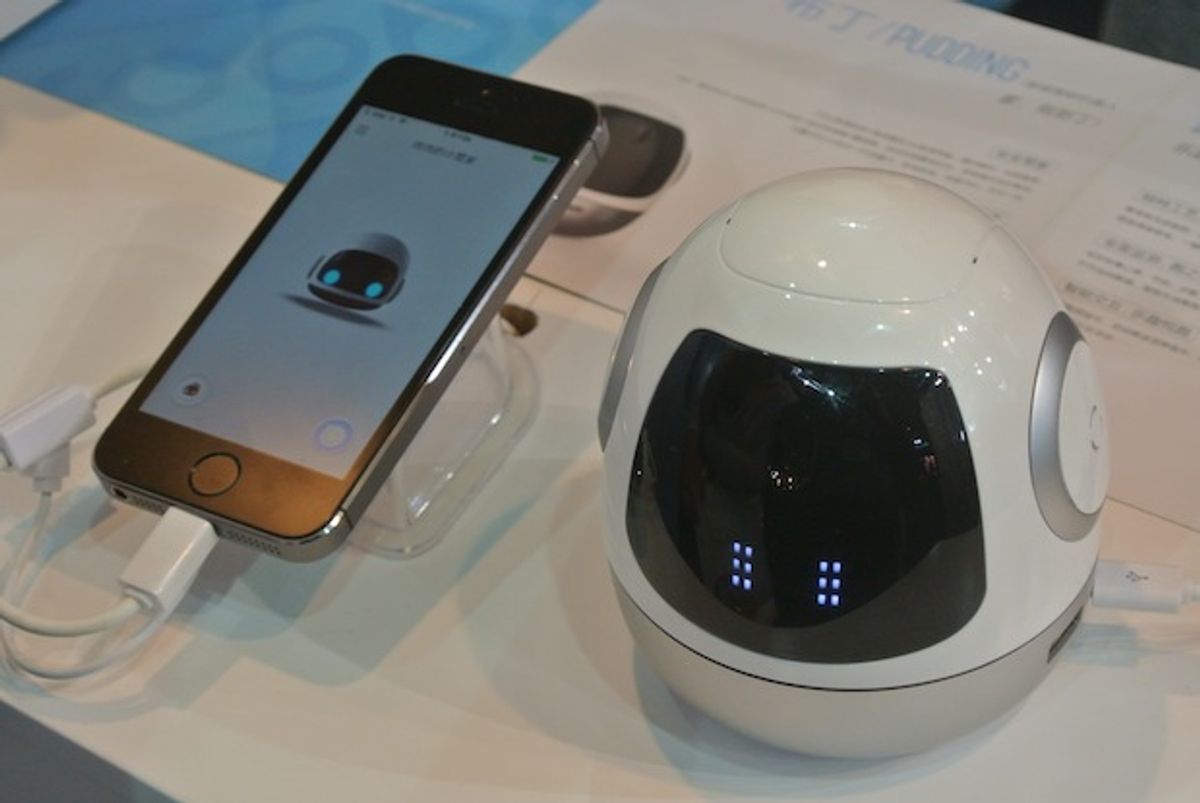Roobo Pudding
This is probably the world’s most adorable security camera. Like a Dropcam, the Pudding allows you to monitor your home via a smartphone app, and even speak to people through a microphone and speaker set up in the camera. Unlike a Dropcam however, Pudding will accept voice commands to do things like play music for you, while conveying various “emotions” using its LED “eyes.” It also comes with a wireless sensor about the size of an overcoat button that can be placed just about anywhere in the house and used to detect the opening of doors or windows out of Pudding’s line of sight. Pudding will go on sale in China in September for a little under US $50.
Fastwheel Ring
The Ring is the latest entry in Fastwheel’s lines of electric monocycles designed to be ridden by standing on their footrests (think of a Segway without all the extravagant messing about with a handle and a second wheel). When I first saw Fastwheel’s earlier product—the Eva—at CES Las Vegas, it struck me as something of a flash-in-the-pan stunt product that few people would actually buy. But exploring outside of CESAsia, I’ve seen similar monocycles for sale in several stores in one of Shanghai’s sprawling electronics and fashion markets, and I did spot a person whizzing down the road through scooter traffic riding one. The company says it’s been making domestic sales in China and finding customers in Spain, Korea, and Thailand, so it may be only a matter of time before it goes global. The Ring has yet to be released, so there’s no official price, but the Fastwheel Eva’s Pro and Super models clock in at US $280 and $330 respectively, so the Ring will probably be somewhere around that range.
Sleep Shepherd
This headband doesn’t just track sleep—the manufacturer claims it can actively relax a wearer’s mental state and help them nod off. A set of three electrodes—made of conductive fabric—on the inside of the band monitors brainwaves. This information is used to create slightly different tones in a pair of built in headphones. The idea is that adjusting the frequency difference between the tones can stimulate longer, more relaxed brainwaves. As the wearer’s brainwaves adapt to one set of tones, the electrodes sense it and change the tones with the aim of lengthening the brainwaves even more. This goes on until a state of sleep has been reached. For US $150 you can see if it works for you.
Aquatic Speakers
Like smartwatches and fitness trackers, floating waterproof wireless music speakers are apparently a distinct product category now, as demonstrated by the fact I ran across three different companies making them. They all have somewhat similar specs and prices; representative of the group are the brightly-colored, lozenge shaped speakers from Zupool [above], which will be released in the last quarter of 2015 and will cost about US $80 retail.
ViLover
This is a prototype of a headset and controller designed for virtual reality software with adult content. (The software runs on a smartphone that fits into the case and acts as the device’s display.) The creators hope to bring it into production by launching an Indiegogo campaign later this year. But be warned: This is not the beginning of a richly textured voyage into a new form of erotica. Based on the demo material, it’s solely and crudely aimed at what a heterosexual teenage boy might find intriguing.
Pao Smile Trainer
Okay, this one isn’t remotely electrotech, but the packaging—featuring an oh-so-earnest model demonstrating how to use it to improve one’s “facial fitness”—made me crack up on the show floor. The idea is that you hold the Pao (from Hong Kong company Shlab) between your teeth and then bob your head up and down for 30 seconds, two times a day. Different weights can used to increase resistance during the bobbing. The result, apparently, is a youthful smile for a mere US $125.
The fact that Twitter had a booth, in a country where the entire population of 1.3 billion can’t officially access the social media service, perplexed me at first. But it turns out that while Chinese companies can’t use Twitter to speak to their domestic audience, they will happily buy advertising on it to reach the international market.
Stephen Cass is the special projects editor at IEEE Spectrum. He currently helms Spectrum's Hands On column, and is also responsible for interactive projects such as the Top Programming Languages app. He has a bachelor's degree in experimental physics from Trinity College Dublin.











